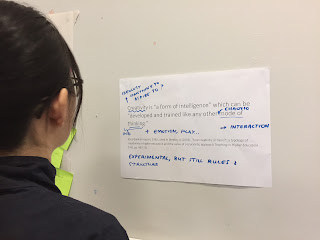Last week I participated in a workshop led by the Institute for Academic Development on ‘teaching outside the box’. I really enjoyed the first half of the session when we worked collaboratively in groups to define ‘creativity’ and then to define ‘teaching’ separately, followed by the development and critique of our own definitions of ‘creative teaching’.
First, it was striking that for our group and for the others, the words we associate with creativity (such as ‘play’, ‘originality’, ‘engaging’, ‘exciting’, ‘dynamic’, and ‘fun’) tend to be much more positive than the words associated with teaching (‘lecture’, ‘content’, ‘learning community’, ‘collaboration’, ‘boring’, ‘contained’, and ‘should be fun’). This was a bit depressing, especially when thinking about recapturing the excitement of lectures to be, as Cathy Bovill suggests, as exciting as an adventure in Legoland® or reflecting on how creative teaching such as co-creation the curriculum benefits both students and staff by developing increased engagement with and enjoyment of learning.
It was challenging to create a concise yet all-encompassing definition of ‘creative teaching’. Our group came up with: a flexible and fun process that actively engages students and teachers in a challenging, collaborative learning experience. We wanted to emphasise that creative teaching can and should be messy and challenging, but it can also be extremely rewarding, meaningful, and beneficial for both students as staff when they overcome challenges together (for example, see my previous post about my research article). I enjoyed seeing the other groups’ definitions of creative teaching, for example the one that emphasised the tools, concepts, actions, and aspects of reflection that are embedded in creative teaching. By using stickers, it was also helpful to see which concepts resonated most with the group.
This exercise and subsequent collaborative review and critique of various definitions of creativity were extremely interesting and also beneficial for my forthcoming article on creativity in co-creation of the curriculum, which draws on some of my recent research and a presentation on creativity in learner engagement. It was helpful to have the space to step back from day-to-day activities and reflect on these concepts through having meaningful conversations with colleagues.
The second half of the workshop consisted of unstructured exploration of five different types of creative teaching methods, but unfortunately the lack of structure or case studies of how these activities were used in the classroom made the activities fall a bit flat. For me, this emphasised how creativity and fun can be important aspects of teaching excellence, but they can’t be implemented superficially just for the sake of it and need to be incorporated alongside clear learning expectations to add to and enhance engagement with academic subject content. See my previous work on teaching excellence and my article addressing challenges of co-creation for more on this, and stay tuned for my research article on creativity.
First, it was striking that for our group and for the others, the words we associate with creativity (such as ‘play’, ‘originality’, ‘engaging’, ‘exciting’, ‘dynamic’, and ‘fun’) tend to be much more positive than the words associated with teaching (‘lecture’, ‘content’, ‘learning community’, ‘collaboration’, ‘boring’, ‘contained’, and ‘should be fun’). This was a bit depressing, especially when thinking about recapturing the excitement of lectures to be, as Cathy Bovill suggests, as exciting as an adventure in Legoland® or reflecting on how creative teaching such as co-creation the curriculum benefits both students and staff by developing increased engagement with and enjoyment of learning.
It was challenging to create a concise yet all-encompassing definition of ‘creative teaching’. Our group came up with: a flexible and fun process that actively engages students and teachers in a challenging, collaborative learning experience. We wanted to emphasise that creative teaching can and should be messy and challenging, but it can also be extremely rewarding, meaningful, and beneficial for both students as staff when they overcome challenges together (for example, see my previous post about my research article). I enjoyed seeing the other groups’ definitions of creative teaching, for example the one that emphasised the tools, concepts, actions, and aspects of reflection that are embedded in creative teaching. By using stickers, it was also helpful to see which concepts resonated most with the group.
This exercise and subsequent collaborative review and critique of various definitions of creativity were extremely interesting and also beneficial for my forthcoming article on creativity in co-creation of the curriculum, which draws on some of my recent research and a presentation on creativity in learner engagement. It was helpful to have the space to step back from day-to-day activities and reflect on these concepts through having meaningful conversations with colleagues.
The second half of the workshop consisted of unstructured exploration of five different types of creative teaching methods, but unfortunately the lack of structure or case studies of how these activities were used in the classroom made the activities fall a bit flat. For me, this emphasised how creativity and fun can be important aspects of teaching excellence, but they can’t be implemented superficially just for the sake of it and need to be incorporated alongside clear learning expectations to add to and enhance engagement with academic subject content. See my previous work on teaching excellence and my article addressing challenges of co-creation for more on this, and stay tuned for my research article on creativity.




No comments:
Post a Comment